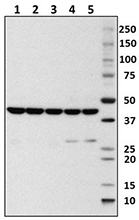- Clone
- FF26A/F9 (See other available formats)
- Regulatory Status
- RUO
- Other Names
- glyceraldehyde-3-phosphate dehydrogenase
- Isotype
- Mouse IgG1, κ
- Ave. Rating
- Submit a Review
- Product Citations
- publications

-

Whole cell extracts (15 µg protein) from HeLa cells were resolved on a 4-12% Bis-Tris gel, transferred to a nitrocellulose membrane and probed with 1.0 µg/mL (1:500 dilution) of Purified anti-GAPDH Antibody, clone FF26A/F9, overnight at 4°C. Proteins were visualized by chemiluminescence detection using HRP goat anti-mouse IgG Antibody (Cat. No. 405306) at a 1:3000 dilution. Lane M: Molecular Weight marker.
| Cat # | Size | Price | Quantity Check Availability | Save | ||
|---|---|---|---|---|---|---|
| 649201 | 25 µg | 100€ | ||||
| 649202 | 100 µg | 184€ | ||||
This mouse monoclonal GAPDH antibody recognizes human GAPDH, also known as glyceraldehyde-3-phosphate dehydrogenase. GAPDH is well known for its glycolytic function of converting D-glyceraldehyde-3-phosphate to 1,3-bisphosphoglycerate. GAPDH is a ubiquitously expressed and has a molecular mass of 36 kD. Though differentially expressed from tissue to tissue, GAPDH is frequently used as a loading control for assays involving mRNA and protein detection. In more recent studies, GAPDH has been shown to be involved in microtubule bundling, prostate cancer progression, programmed neuronal cell death, DNA replication, and DNA repair. Recent work has elucidated roles for GAPDH in apoptosis, gene expression and nuclear transport. GAPDH may also play a role in neurodegenerative pathologies such as Huntington and Alzheimer's diseases. The FF26A/F9 monoclonal antibody has been shown to be useful for Western blotting.
Product DetailsProduct Details
- Verified Reactivity
- Human
- Antibody Type
- Monoclonal
- Host Species
- Mouse
- Immunogen
- Human CD4 lymphocytes
- Formulation
- This antibody is provided in phosphate-buffered solution, pH 7.2, containing 0.09% sodium azide.
- Preparation
- The antibody was purified by affinity chromatography.
- Concentration
- 0.5 mg/ml
- Storage & Handling
- Upon receipt, store undiluted between 2°C and 8°C.
- Application
-
WB - Quality tested
IHC, IP - Reported by the developer, not verified in house - Recommended Usage
-
Each lot of this antibody is quality control tested by Western blotting. Western blotting, suggested working dilution(s): Use 0.1 - 1.0 µg antibody per 1 ml antibody dilution buffer for each mini-gel. It is recommended that the reagent be titrated for optimal performance for each application.
- Application Notes
-
The optimal concentration should be determined by titration for each individual assay of interest.
Clone FF26A/F9 is only reactive to human GAPDH, and not cross-reactive to mouse or rat GAPDH. -
Application References
(PubMed link indicates BioLegend citation) -
- Maestre L, et al. 2009. Haematologica. 94:419.
- Zou L, et al. 2012. J Biol. Chem. 287:7190. PubMed
- Chen CY, et al. 2012. PNAS. 110:630 PubMed
- Trifari S, et al. 2013. PNAS. PubMed
- Liu CC, et al. 2013. Mol. Cell Biol. 33:4334. PubMed
- Trifari S, et al. 2013. PNAS. 110:18608. PubMed
- Butin-Israeli V, et al. 2015. Mol. Cell Biol. 35:884. PubMed
- Product Citations
-
- RRID
-
AB_10613283 (BioLegend Cat. No. 649201)
AB_10612752 (BioLegend Cat. No. 649202)
Antigen Details
- Structure
- Belongs to the glyceraldehyde-3-phosphate dehydrogenase family, predicted molecular weight 36 kD. The enzyme exists as a tetramer of identical chains.
- Distribution
-
Ubiquitously expressed, locate in cytoplasm and perinuclear region.
- Function
- Glyceraldehyde-3-phosphate dehydrogenase (GAPDH) catalyzes an important energy-yielding step in carbohydrate metabolism, the reversible oxidative phosphorylation of glyceraldehyde-3-phosphate in the presence of inorganic phosphate and and nicotinamide adenine dinucleotide (NAD). Independent of its glycolytic activity it is also involved in membrane trafficking in the early secretion pathway.
- Interaction
- Interacts with TPPP. Interacts with EIF1ADand WARS. Interacts with SUMO4, GLUT4, nPKC-iota and CAMK2
- Biology Area
- Cell Biology, Neurodegeneration, Neuroscience, Protein Misfolding and Aggregation, Signal Transduction
- Antigen References
-
1. Ercolani L, et al. 1988. J. Biol. Chem. 263:15335.
2. Meyer-Siegler K, et al. 1991. P. Natl. Acad. Sci. USA 88:8460.
3. Hara MR and Snyder SH. 2006. Cell Mol. Neurobiol. 26:527.
4. Zheng L, et al. 2003. Cell. 114:255.
5. Wang Q, et al. 2005. FASEB J. 19:869.
6. Bae BI, et al. 2006. P. Natl. Acad. Sci. USA. 103:3405. - Gene ID
- 5590 View all products for this Gene ID
- UniProt
- View information about GAPDH on UniProt.org
Related Pages & Pathways
Pages
Related FAQs
Other Formats
View All GAPDH Reagents Request Custom Conjugation| Description | Clone | Applications |
|---|---|---|
| Purified anti-GAPDH | FF26A/F9 | WB,IHC,IP |
| Direct-Blot™ HRP anti-GAPDH | FF26A/F9 | WB |
Customers Also Purchased



Compare Data Across All Formats
This data display is provided for general comparisons between formats.
Your actual data may vary due to variations in samples, target cells, instruments and their settings, staining conditions, and other factors.
If you need assistance with selecting the best format contact our expert technical support team.
-
Purified anti-GAPDH

Whole cell extracts (15 µg protein) from HeLa cells were res... -
Direct-Blot™ HRP anti-GAPDH
15 µg of total protein extract from HeLa cells was resolved...
 Login / Register
Login / Register 









Follow Us